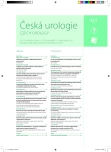Mathematical modeling of penile deformation in Peyronie’s disease after shock wave therapy
Authors:
Pavel Drlík 1; Jan Loško 2; Vladimír Křístek 2; Oto Köhler 1
Authors‘ workplace:
Urologické oddělení ÚVN, Praha
1; Fakulta stavební ČVUT, Praha
2
Published in:
Ces Urol 2012; 16(1): 37-42
Category:
Original article
Overview
Aim:
Mathematical modeling of penile deformation in Peyronie’s disease after shock wave therapy.
Methods:
Initially, a model of the penis in flacid and in erect state was created. The Finite Element Method Analysis was used. Subsequently the same model was used to analyse the penis affected by a fibrous plaque. The rigid element had the following characteristics: it was not possible to stretch it on external impulse and its stiffness on the contrary restricted free expansion of surrounding elements and induced deformity of the object. Finally we analyzed the model for successful and unsuccessful treatment with shock waves, which were delivered by the lithotriptor Medilit 7. The task was derived from real average size parameters of the object, average plaque size, average extent of deviation and average improvement of deformity in patients treated at our department.
Results:
The mathematical model showed that the deflection of the erected penis is in the directionof the rigid component (fibrous plaque). The plaque itself is affected by significant tensile stress that can cause its transverse narrowing; significant tension also arises around theplaque. Significant deviation of the penis resultsin negative effect on function and qualityof life.
Conclusion:
Based on the application of mathematical models we can reduce undesirable deformity of the penis during erection either by removal of the whole rigid element via surgery or by disrupting the affected element, so that during erection its reduced rigidity does not restrict volume changes of the adjacent area – this is likely the principle applied with application oft he shock wave treatment.
Key words:
mathematical model, Peyronie’s disease, shock wave, dorsal angulation.
Sources
1. Muller A, Akin-Olugbade Y, Deveci S, et al. The Impact of Shock Wave Th erapy at Varied Energy and Dose Levels on Functional and Structural Changes in Erectile Tissue. Eur Urol 2008; 53 : 635–643.
2. La Peyronie F. Sur quelques obstacles qui s’opposent à l’ejaculation naturele de la semence. Mem Acad Royale Chir 1743; 1 : 337–342.
3. Van de Water L. Mechanisms by which fi brin and fi bronectin appear in healing wounds: implications for Peyronie’s disease. J Urol 1997; 157 : 306–310.
4. Devine CJ. Introduction to Peyronie’s Disease. J Urol 1997; 157 : 272–275.
5. Williams G, Green NA. Th e non-surgical treatment of Peyronie’s disease. Br J Urol 1980; 52 : 392–395.
6. Yaschia D. Corporal plication for surgical of Peyronie’s disease. J Urol 1993, 149 : 869.
7. Levine LA. Review of current nonsurgical management of Peyronie’s disease. Int J Import Res 2003; 15 : 113–120.
8. Drlík P, Kőhler O. Naše zkušenosti s aplikací rázové vlny u pacientů s induratio penis plastica (průměrná doba sledované 13 měsíců). Ces Urol 2010; 14(3): 1–3.
Labels
Paediatric urologist Nephrology UrologyArticle was published in
Czech Urology

2012 Issue 1
Most read in this issue
- Complications associated with indwelling urethral catheter aft er major joint arthroplasty in men
- How safe is active surveillance strategy of small renal masses?
- Use of neuromodulation in the treatment of lower urinary tract dysfunction
- Bilateral adrenalectomy – in patients with Cushing’s syndrome due to ectopic secretion of ACTH
